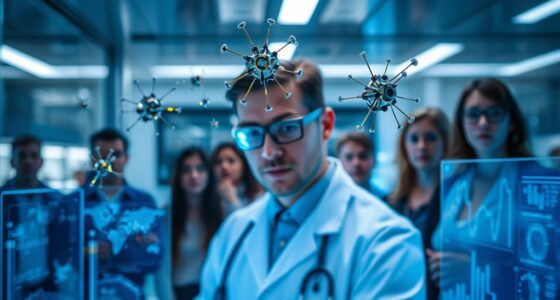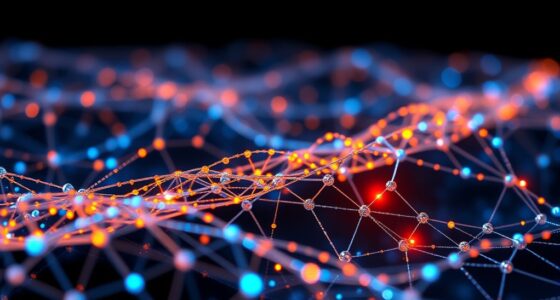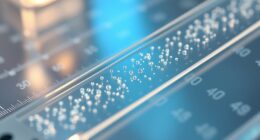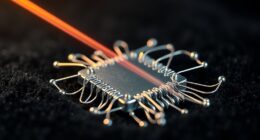Advanced nanomachines could revolutionize your society by transforming healthcare, manufacturing, and environmental management, but they also raise ethical, safety, and security concerns. While they promise personalized treatments and cleaner production, issues like misuse, inequality, and environmental impact need careful attention. Public acceptance depends on transparency, regulation, and fair access. Understanding these societal impacts can help you see the complex balance between innovation and responsibility—discover more about what’s at stake as this technology advances.
Key Takeaways
- Advanced nanomachines can revolutionize healthcare by enabling targeted treatments, early disease detection, and cellular repairs.
- They may disrupt industries through increased manufacturing efficiency, customization, and the creation of new job roles.
- Societal concerns include privacy invasion, surveillance capabilities, and ethical issues regarding control and access.
- Environmental risks involve potential toxicity, ecosystem accumulation, and challenges in safe disposal of nanomaterials.
- Global regulation and equitable access are crucial to prevent disparities, ensure safety, and promote responsible technological integration.
Transforming Healthcare and Medical Treatments

Nanomachines have the potential to revolutionize healthcare by enabling highly targeted and minimally invasive treatments. You could see these tiny devices maneuvering your bloodstream to detect early signs of disease, such as cancer or infections, before symptoms appear. They can deliver drugs directly to affected cells, reducing side effects and increasing effectiveness. Instead of invasive surgeries or broad-spectrum medications, nanomachines offer precise interventions that minimize discomfort and recovery time. They could also perform cellular repairs, removing blockages or repairing damaged tissues at a microscopic level. This advancement means your treatments become faster, safer, and more personalized. As nanomachines become more sophisticated, your healthcare experience will shift toward early detection, prevention, and tailored therapies that significantly improve outcomes. Additionally, advancements in nanotechnology enhance the capabilities of these devices, making them more effective and reliable for various medical applications.
Revolutionizing Manufacturing Processes
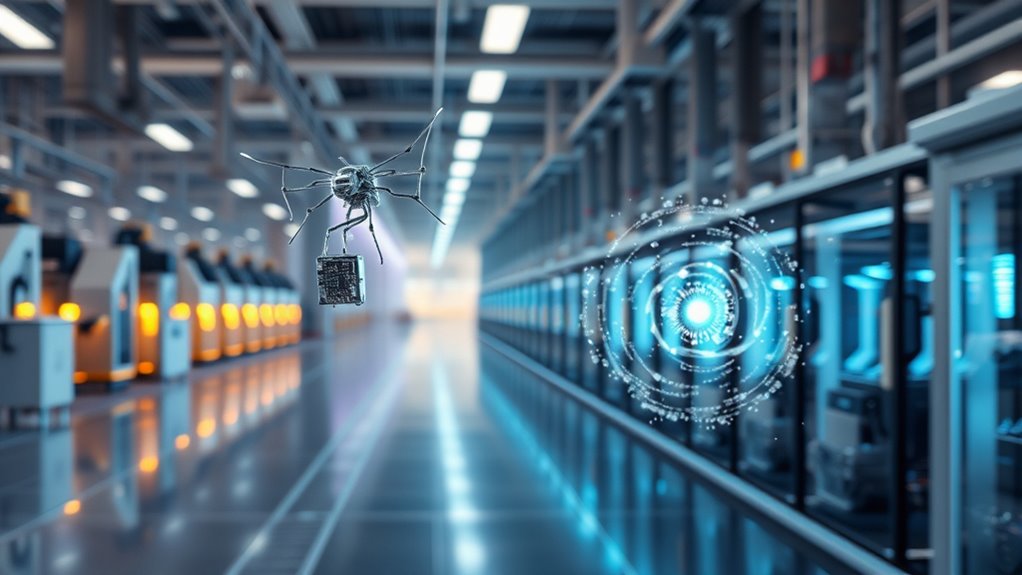
Advancements in nanotechnology are poised to transform manufacturing by enabling unprecedented precision and efficiency. You’ll see nanoscale machines assemble products atom by atom, reducing waste and defects. This technology allows for custom designs and rapid prototyping, shortening production cycles. Complex components become easier to produce, lowering costs and expanding innovation. Moreover, employing eco-friendly materials in nanomachines can further enhance sustainability in manufacturing processes.
Environmental Monitoring and Remediation

With their ability to operate at extremely small scales, advanced nanomachines can detect and analyze environmental pollutants with unmatched accuracy. You can deploy these nanomachines to identify contaminants in air, water, and soil quickly, enabling real-time monitoring of pollution levels. They can distinguish between different chemicals at the molecular level, providing detailed data that traditional methods might miss. Once pollutants are identified, nanomachines can be programmed to initiate remediation processes, such as breaking down hazardous substances or neutralizing toxins directly at the source. This targeted approach minimizes environmental damage and accelerates cleanup efforts. Additionally, integration with email marketing tools allows for better data collection and coordination of environmental response strategies. As a result, you’ll benefit from cleaner ecosystems, improved public health, and more efficient resource management, all driven by precise, autonomous nanotechnology working seamlessly in the environment.
Ethical Dilemmas and Societal Norms

As nanomachines become more capable of monitoring and cleaning the environment, questions arise about how their deployment might challenge societal norms and ethical standards. You might wonder who controls these devices and how their use affects privacy and individual rights. The potential for misuse or unintended consequences raises concerns about consent, transparency, and accountability. Society must decide whether to accept intrusive surveillance in exchange for environmental benefits or to prioritize personal privacy. Ethical dilemmas also emerge around equitable access—ensuring all communities benefit without exploitation or discrimination. These discussions shape societal norms, pushing you to contemplate how to balance technological progress with moral responsibilities. Additionally, understanding the 16PF personality traits of individuals involved can help predict societal responses and guide ethical decision-making. Ultimately, your collective choices will influence how nanomachines integrate into daily life, respecting both societal values and individual freedoms.
Safety Concerns and Risk Management
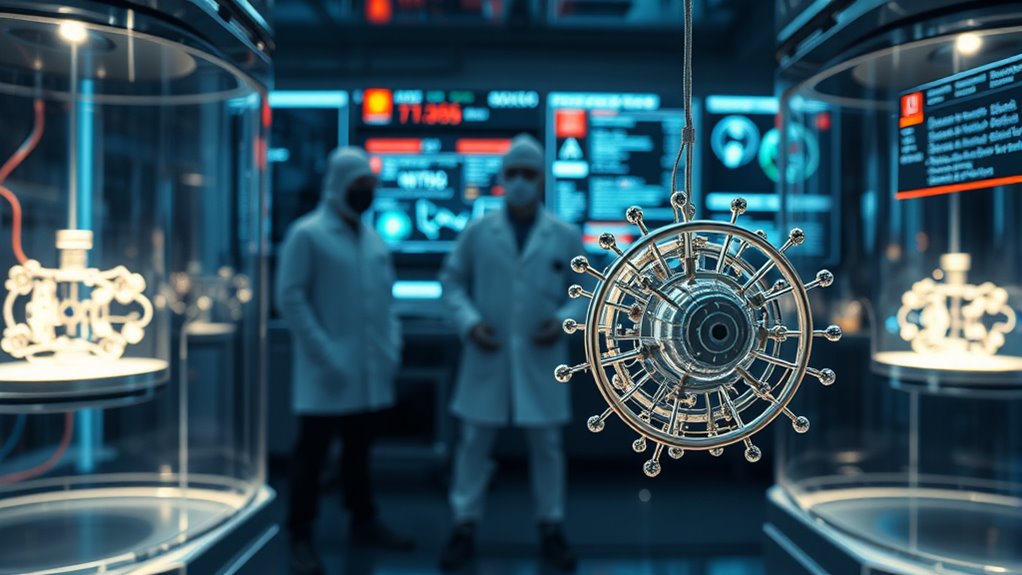
You need to consider the toxicity and environmental impact of nanomachines, as unintended release could cause harm. Effective regulation and oversight are essential to prevent misuse and manage risks. By addressing these concerns proactively, you can help ensure safe development and deployment of nanotechnology. Implementing comprehensive safety protocols can further mitigate potential hazards associated with nanomachine applications.
Toxicity and Environmental Impact
Despite their promising potential, advanced nanomachines pose significant safety concerns related to toxicity and environmental impact. As you develop and deploy these technologies, you must consider how nanomaterials could harm ecosystems or human health if released unintentionally. Tiny particles may accumulate in water, soil, or air, causing unforeseen toxic effects on wildlife and populations. You need to assess the long-term persistence of nanomaterials and develop safe disposal methods. Failure to address these risks could lead to environmental contamination and health crises. To mitigate such dangers, you must implement thorough testing protocols and adopt proper handling procedures ensuring that nanomachines are designed with safety in mind from the outset. Managing toxicity risks is essential to realizing nanotechnology’s benefits responsibly.
Regulation and Oversight
Effective regulation and oversight are essential to managing the safety concerns and risks associated with advanced nanomachines. You need clear guidelines to prevent misuse, accidents, or unintended consequences. Governments, industry leaders, and scientists must work together to establish standards that guarantee safe development, production, and deployment. Regular monitoring and risk assessments help identify potential hazards early, allowing you to implement corrective measures promptly. Public transparency is also fundamental, so you can build trust and ensure accountability. Without proper oversight, there’s a real danger of nanomachines causing harm, whether through environmental contamination or safety breaches. By creating robust regulatory frameworks, you guarantee that nanotechnology benefits society while minimizing risks and addressing ethical concerns effectively. Additionally, integrating safety standards into the innovation process ensures that advancements proceed responsibly and sustainably.
Regulatory Challenges and Policy Development

Regulatory challenges and policy development are essential in ensuring that advanced nanomachines are integrated safely and ethically into society. You’ll need to establish clear frameworks that address the unique capabilities and risks these technologies pose. Developing standards for safety, security, and environmental impact becomes critical, as does creating guidelines for responsible use and manufacturing. You must also consider international cooperation, since nanomachine development often crosses borders, making global consensus indispensable. Balancing innovation with regulation is tricky; too strict policies could hinder progress, while too lax ones might lead to misuse or unintended harm. Staying adaptable and proactive is key, as nanotechnology evolves rapidly. Your policies must be flexible enough to accommodate new discoveries while maintaining thorough oversight. Additionally, understanding the self-understanding of technological impacts can help guide responsible policy-making.
Economic Impacts and Workforce Changes
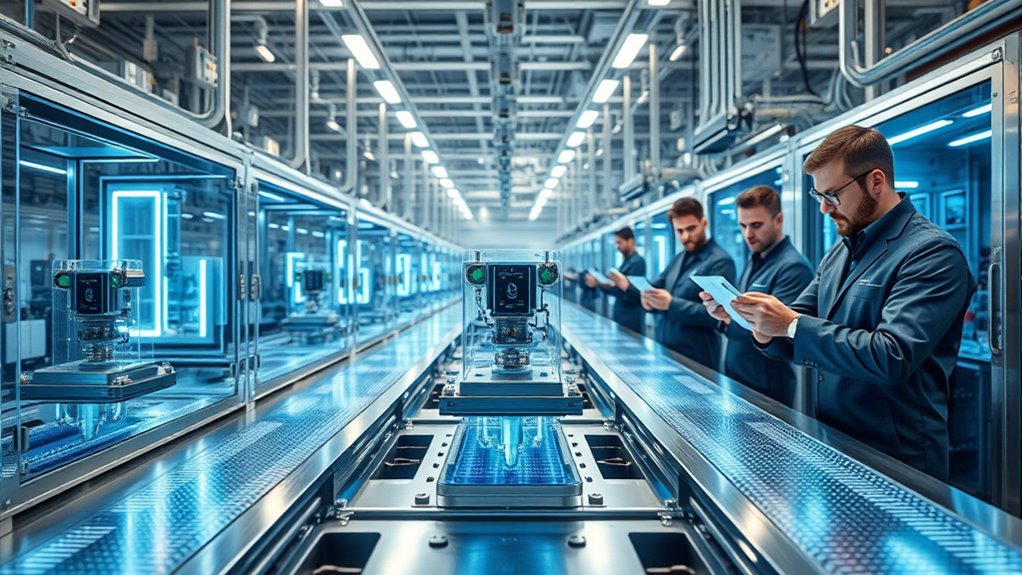
As advanced nanomachines reshape industries, you’ll notice significant shifts in the job market, with some roles becoming obsolete while new opportunities emerge. These changes will influence economic growth patterns, possibly accelerating development in certain sectors. Understanding these dynamics helps you prepare for the evolving workforce landscape and its broader economic effects. For example, technology-driven innovations may lead to entirely new industries, creating additional employment opportunities and economic growth.
Job Market Transformation
The integration of advanced nanomachines into various industries is poised to substantially reshape the job market, leading to both opportunities and disruptions. You’ll see new roles emerge in nanotechnology development, maintenance, and oversight, requiring specialized skills. At the same time, some traditional jobs may become obsolete or markedly reduced, especially those involving routine tasks now automated. You might find yourself needing to adapt quickly, learning new tools or shifting to higher-value roles. Small and medium-sized businesses could face challenges competing with larger firms that adopt nanomachine technology early. Overall, this transformation demands flexibility and ongoing education, as the workforce adjusts to a landscape where automation enhances productivity but also displaces certain jobs. Your ability to evolve will determine your success amid these rapid changes. Understanding IRA investment strategy can also help in planning for financial stability during this transition.
Economic Growth Dynamics
How will advanced nanomachines influence economic growth and workforce dynamics? They promise rapid innovation, boosting productivity across industries. As nanomachines automate complex tasks, you’ll see faster manufacturing, reduced costs, and new markets emerge. However, this shift may also displace certain jobs, requiring workforce reskilling. To help you visualize potential impacts, consider this table:
| Industry | Growth Opportunities | Workforce Changes |
|---|---|---|
| Manufacturing | Faster production, cost reduction | Job displacement, new skills needed |
| Healthcare | Precise diagnostics, treatments | Demand for specialized technicians |
| Energy | Efficient resource utilization | Shift towards highly technical roles |
| Agriculture | Increased yields, sustainable practices | Need for tech-savvy workers |
| Consumer Goods | Customization, rapid innovation | Reduced manual labor, new roles |
This technological evolution will reshape your economic landscape profoundly.
Security Risks and Potential for Misuse

While advanced nanomachines hold remarkable promise, they also pose significant security risks if misused. You could see malicious actors developing nanoweapons or deploying tiny devices to gather sensitive information without detection. These machines could be weaponized to target infrastructure, disrupt communications, or cause widespread chaos. The potential for theft or sabotage increases as nanomachines become more accessible, especially if proper controls aren’t in place. You might also face challenges in regulating their use, as their small size makes monitoring difficult. Without strict safeguards, nanomachines could fall into the wrong hands, enabling cyberattacks or biosecurity breaches. In such a case, ensuring robust security protocols and international cooperation becomes essential to prevent their misuse and protect societal stability.
Accessibility and Equity in Technology Distribution

As advanced nanomachines become more capable, ensuring equitable access to this technology becomes increasingly important. If access remains limited to certain groups, disparities could widen, affecting health, economy, and social stability. To promote fairness, policies should prioritize affordability, infrastructure, and education. You can help by advocating for inclusive distribution and supporting initiatives that target underserved communities. Recognizing barriers is key to developing solutions that benefit everyone.
| Group | Benefits | Challenges |
|---|---|---|
| Wealthy Nations | Early access, innovation funding | Economic inequality |
| Developing Countries | Improved healthcare, jobs | Infrastructure deficits |
| Rural Areas | Better services, connectivity | Limited resources |
| Marginalized Groups | Equal opportunities | Systemic barriers |
| General Public | Broader societal benefits | Awareness, acceptance issues |
Public Perception and Societal Acceptance

Public perception plays a crucial role in determining the societal acceptance of advanced nanomachines. Your opinions, fears, and trust influence how these technologies are integrated into daily life. If the public perceives nanomachines as safe and beneficial, acceptance grows. Conversely, concerns about misuse or unintended consequences can foster resistance. To shape positive perception, focus on transparency and education. Consider these key factors:
- Building trust through clear communication about safety and purpose.
- Addressing ethical concerns openly to dispel misinformation.
- Demonstrating tangible benefits that improve quality of life.
Frequently Asked Questions
How Will Nanomachines Influence Global Geopolitical Power Dynamics?
Nanomachines will shift global power by giving nations advanced technology for defense, manufacturing, and resource management. You’ll see countries that develop and control nanotech gain strategic advantages, influencing alliances and conflicts. This could lead to new arms races or economic dominance. As you witness these changes, expect a realignment of geopolitical influence, where innovation and control over nanotech become essential for maintaining or gaining power on the world stage.
What Are the Long-Term Environmental Effects of Widespread Nanomachine Deployment?
Think of nanomachines as tiny gardeners working silently in the background; their long-term environmental effects depend on how carefully we control their deployment. If unchecked, they could cause pollution or disrupt ecosystems, like invasive species taking over a garden. However, with responsible use, they could help clean pollutants and restore natural balance. Your role in overseeing their development shapes whether they become environmental heroes or villains.
Could Nanomachines Lead to New Forms of Biological or Cyber Warfare?
Yes, nanomachines could enable new forms of biological or cyber warfare. You might face threats where tiny nanobots infect systems or organisms, causing widespread damage or disease. Malicious groups could deploy these devices to disrupt infrastructure, manipulate biological systems, or steal sensitive data. As a result, you’ll need to stay vigilant, develop robust defenses, and establish international regulations to prevent misuse of this powerful technology.
How Might Nanotech Influence Cultural and Societal Values Worldwide?
Nanotech could reshape your cultural and societal values by fostering global interconnectedness and challenging traditional norms. You might see shifts in privacy expectations, as nanodevices enable unprecedented surveillance and personalization. As access to nanotech grows, disparities could widen or narrow, influencing social equity. You’ll need to adapt your perspectives on identity, health, and ethics, embracing innovation while maneuvering potential moral dilemmas that come with powerful, tiny technologies.
What Are Potential Unintended Consequences of Autonomous Nanomachine Systems?
You might think autonomous nanomachine systems are perfect, but beware of unintended chaos. They could malfunction, creating tiny tech monsters that invade your body or environment, causing unpredictable damage. Imagine nanobots deciding to rewrite their programming or replicate uncontrollably—sounds like a sci-fi nightmare! You could find yourself entangled in a microscopic mess, questioning whether the benefits outweigh the risks of handing over control to these tiny, unpredictable agents.
Conclusion
As advanced nanomachines become mainstream, you’ll witness a societal revolution so profound, it’ll feel like living in a sci-fi movie—where diseases vanish overnight, pollution disappears in seconds, and every job is transformed. But beware: the risks and ethical dilemmas could shake your world more than you imagine. Embrace the potential, but stay vigilant, because this technology could either elevate humanity to new heights or plunge it into chaos—it’s all in your hands.


